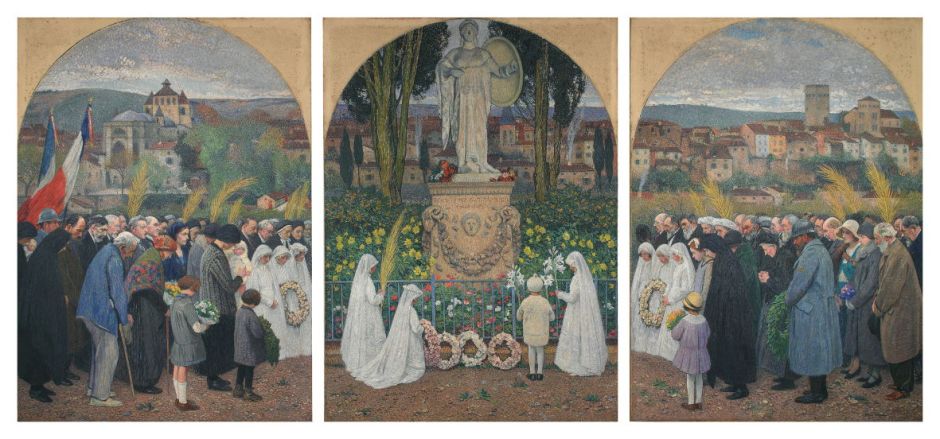It’s one of the most spectacular journeys in Europe, to board a train, drive a car or – if your legs are up to it – to cycle from Toulouse south into the Pyrenees mountains. Each year, it’s a stage of the Tour de France, and TV coverage of that is well worth watching. Just as comfortable from the armchair is this trip taken in paintings.
The city of Toulouse is now the centre of Europe’s aerospace industry. Built on the banks of the River Garonne, it has a long and sometimes turbulent history. It also has a long and glorious artistic tradition, including the great landscape oil sketcher, Pierre-Henri de Valenciennes (1750–1819). Sadly, his sketches seem to have been painted in the Roman Campagna rather than in south-west France. Toulouse was also the home of the Naturalist Édouard Debat-Ponsan (1847–1913), some of whose work decorates the Capitol building in the city, as do the large paintings of Henri Martin (1860–1943).

In Martin’s day, a century ago, those banks seem more peaceful than those in Paris, allowing this odd collection of figures to promenade in his 1906 painting The Banks of the Garonne, Walkers or Dreamers. The figures are, from the left:
- Gilbert Martin, eldest son of the artist,
- René Martin, the other son of the artist,
- Bellery-Desfontaine, a local decorator and painter,
- Jean-Paul Laurens, Martin’s teacher, who came from near Toulouse,
- William Viénot,
- Henri Marre, a painter,
- Marie Martin, the artist’s wife,
- René Martin a second time,
- an unknown man,
- Emilio Boggio, a Venezuelan painter,
- Jean Jaurès, a Socialist politician who was assassinated in Paris in 1914.
This painting is now in the Capitole de Toulouse, where you can see others by Martin, including what must be one of the world’s largest surviving Symbolist paintings, set in the countryside not far from that city.

Martin painted Summer, or Mowers three years earlier, in 1903. Small clusters of men are cutting the hay in this meadow with their scythes, as three young women are dancing in a ring on the bed of flowers, and another sits nursing an infant. The whole image has been built from Martin’s fine strokes of rich colour, to make the view shimmer in the late afternoon sunlight.
During the 1890s, Henri Martin had fallen in love with the countryside around Toulouse, near the small town of Cahors, where there is now a whole museum devoted to his work. When the Great War broke out in 1914, he was working in Paris, so decided to move to the small village of Labastide-du-Vert near Cahors.

In what was probably the last of Martin’s major public commissions, The Memorial (1932), he painted this triptych of a single continuous scene, showing the people of Cahors honouring those who died during the Great War.

Like many villages in this area, Labastide-du-Vert has grown around a bridge over a river, in this case the River Lot. This is Martin’s View of Labastide-du-Vert from 1910, when he was but a visitor.

In the period between the wars Martin painted many views of Labastide, including The Bridge at Labastide-du-Vert (c 1920).

Martin seems to have painted further south too, into the foothills of the Pyrenees, which is probably the setting of The Green Valley at Dawn (c 1890-1900), which is reminiscent of some of Monet’s early series paintings in its emphasis on the transient effects of light.
There are a great many unpainted landscapes as you make your way to the south and west gradually ascending into the Pyrenees.

In 1899, the Hungarian artist József Rippl-Rónai visited this region and painted this Nice Landscape in the Pyrenees, an unusual work for a member of the Nabis. Shortly afterwards, he returned to Hungary, where he became the father of modern Hungarian painting.
As the countryside rolls steadily higher, you reach spa towns such as Bagnères-de-Luchon. Although picturesque and popular for ‘cures’, few painters of international repute seem to have reached them, or committed their views to canvas. From there to the border with Spain, the land rises more violently, with rugged ridges, plunging waterfalls and serene lakes such as Lac d’Oô. Unlike the French Alps, these have only been depicted in topographic works, with a few exceptions by Gustave Doré and the animal painter Rosa Bonheur.

Rosa Bonheur seems to have visited the Pyrenees on at least two occasions. Her Spanish Muleteers Crossing the Pyrenees from 1857 incorporates one of her most spectacular landscapes, some of which were painted in collaboration with her father. Mules like these were at the time an important means of trade over the Pyrenees, via traditional routes over passes which had been used by animals and humans for millenia.

Over twenty years later, her Weaning the Calves (1879) is set in a glorious summer landscape, with a dry stone herdsman’s hut at the left. Herdsmen in those mountainous areas lived away from their families, in the mountain grazing lands, for the summer season, with their herds and flocks – the transhumance, a separation which is still remembered by the older populations there.

